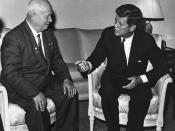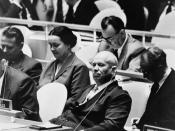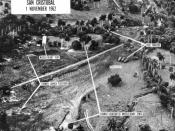The Cuban Missile Crisis was the closest the world ever came to nuclear war. The United States armed forces were at their highest state of readiness ever and Soviet field commanders in Cuba were prepared to use battlefield nuclear weapons to defend the island if it was invaded. Luckily, thanks to the bravery of two men, President John F. Kennedy, and Premier Nikita Khrushchev, war was averted.
In 1962, the Soviet Union was desperately behind the United States in the arms race. Soviet missiles were only powerful enough to be launched against Europe but U.S. missiles were capable of striking the entire Soviet Union. In late April 1962, Soviet Premier Nikita Khrushchev conceived the idea of placing intermediate-range missiles in Cuba. A deployment in Cuba would double the Soviet strategic arsenal and provide a real deterrent to a potential U.S. attack against the Soviet Union.
Meanwhile, Fidel Castro was looking for a way to defend his island nation from an attack by the U.S.
Ever since the failed Bay of Pigs invasion in 1961, Castro felt a second attack was inevitable. Consequently, he approved of Khrushchev's plan to place missiles on the island. In the summer of 1962 the Soviet Union worked quickly and secretly to build its missile installations in Cuba
For the United States, the crisis began on October 15, 1962 when reconnaissance photographs revealed Soviet missiles under construction in Cuba. Early the next day, President John Kennedy was informed of the missile installations. Kennedy immediately organized the EX- COMM, a group of his twelve most important advisors to handle the crisis. After seven days of guarded and intense debate within the upper echelons of government, Kennedy concluded to impose a naval quarantine around Cuba. He wished to prevent the arrival of more Soviet offensive weapons...


